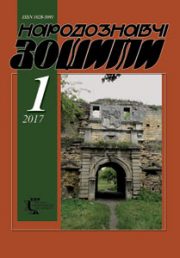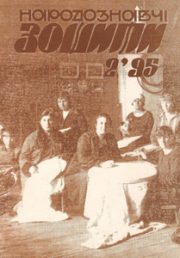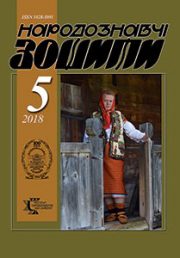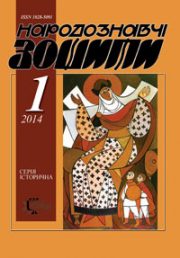The Ethnology Notebooks. 2024. № 2 (176), 283—296
UDK 355.4(470:477)”2014/2024″:355.1-053.18″364″
DOI https://doi.org/10.15407/nz2024.02.283
KILAR Anastasia
- ORCID ID: https://orcid.org/0000-0003-3360-513X
- Junior research associate of the Department of Historical Ethnology,
- Ethnology Institute оf the National Academy of Sciences of Ukraine,
- 15 Svobody ave., Lviv, Ukraine, 79000,
- Contacts: e-mail: anastasiakilar@gmail.com
Abstract. In the article, the death of a Ukrainian soldier was considered from the experience of his comrades. Three key stages were described: the moment of the warrior’s death (emotions, the experiences of fellow soldiers, reaction to the event presently); evacuation of fallen/severely wounded soldiers; removal of bodies/remains of fallen soldiers from the battlefield.
Described the moment of death of Ukrainian soldiers from the experience of their comrades. Ukrainian soldiers had to witness this tragic moment. Special attention is paid to the period of the Russian-Ukrainian war from the point of view of the relevance of this topic.
The experience of losing a brother at the front can be compared to the loss of a loved one. Although the Russian-Ukrainian war has been going on for 10 years, society and the soldiers are still learning to cope with this tragic experience. The experience of loss is still relevant to this day because Russia’s war against Ukraine continues, and since 2022 it has entered a full-scale phase, thereby increasing the number of soldiers killed at the front. This determines the relevance of our topic.
The purpose of the article is to highlight the emotions and experiences of the loss of comrades at the front, as well as to describe the stages from the moment of the Ukrainian soldier’s death to the transportation of his body to his relatives.
The object of the study is a Ukrainian soldier in the period from the beginning of the Russian-Ukrainian war in 2014 to the present day, and the subject is the death of fellow Ukrainian soldiers.
The methodological basis of the research is an interdisciplinary approach, which significantly expands the boundaries of research perspectives. Oral history as a source and method plays a key role in the study of this issue. The territory of the study covers the entire modern territory of Ukraine. Chronological boundaries of the study: from the beginning of the Russian-Ukrainian war in 2014 to the present (including the period of the full-scale Russian invasion of Ukraine after February 24, 2022). The source base of the work was published and unpublished oral history sources, periodicals, media, monographs, field research materials.
Keywords: Russian-Ukrainian war, death, evacuation, soldiers, volunteers, Armed Forces.
Received 9.03.2024
REFERENCES
- Kryshtopa, O., & Kalinovska, O. (2016). About the dead, living and unborn. Heroes of (no)war. Kharkiv: Family Leisure Club [in Ukrainian].
- Koval, R. (2023). My brother was hit by a stray bullet. Kyiv: publishing house Mark Melnyka [in Ukrainian].
- Kharchenko, G. (2019). Artillery’s Diary. Kharkiv: Folio [in Ukrainian].
- Teren, O. (2023). The story of a stubborn man: a story. Kharkiv: Prometheus [in Ukrainian].
- Mulko, A. Information bordering on state secrets: Budanov named the number of the Defense Forces of Ukraine. Telegraph. 17.12.2023. Retrieved from: https://telegraf.com.ua/ukr/ukraina/2023-12-17/5823000-informatsiya-na-mezhi-derzhtaemnitsi-budanov-nazvav-chiselnist-sil-oboroni-ukraini (Last accessed: 29.01.2024) [in Ukrainian].
- «At least 30 thousand»: The Book of Remembrance counted the dead Ukrainian soldiers since the beginning of the Great War. INFOGRAPHICS. Novynarnia. 14.11.2023. Retrieved from: https://novynarnia.com/2023/11/14/knyga-pamyati-22-23/ (Last accessed: 29.01.2023) [in Ukrainian].
- Stuleni, K. «Because the war continues»: a renewed Wall of memory of the victims of Donbas was opened at the Mykhailiv Monastery. PHOTOS, VIDEOS. Novynarnia. 20.08.2020. Retrieved from: https://novynarnia.com/2020/08/20/stina2020/ (Last accessed: 29.01.2024) [in Ukrainian].
- Zagrebelnyi, V., & Bekker, O. The war gives birth to new traditions of honoring the fallen defenders of Ukraine. ArmyInform. 20.10.2022. Retrieved from: https://armyinform.com.ua/2022/10/20/vijna-narodzhuye-novi-tradyczyiy-vshanuvannya-zagyblyh-zahysnykiv-ukrayiny/ (Last accessed: 29.01.2024) [in Ukrainian].
- Zelensky for the first time named the number of dead soldiers of the Armed Forces of Ukraine. What else did he say at the press conference. BBC News Ukraine. 25.02.2024. Retrieved from: https://www.bbc.com/ukrainian/articles/c3ge83ndpxzo (Last accessed: 04.03.2024) [in Ukrainian].
- Unexpectedly (feat. Three Roses). Youtube. 06.04.2023. Retrieved from: https://www.youtube.com/watch?v=AMW_BSpzfEQ (Last accessed: 01.29.2024) [in Ukrainian].
- Medvedenko, L. How to help veterans survive the loss of a comrade in war. ArmyInform. 11.10.2023. Retrieved from: https://armyinform.com.ua/2023/10/11/yak-dopomogty-veteranam-perezhyty-vtratu-pobratyma-na-vijni/ (Last accessed: 30.01.2024) [in Ukrainian].
- Meniv, A. Pain that cannot be described in words: Nazarii Kishak about the death of Oleg Koilyak’s brother. Peak. Carpathian Information Corporation. 18.04.2023. Retrieved from: https://pik.net.ua/2023/04/18/bil-shho-ne-opysaty-slovamy-nazarij-kishak-pro-smert-pobratyma-olega-kojlyaka/ (Last accessed: 30.01.2024) [in Ukrainian].
- «My brother died in my arms»: a National Guardsman serving in Chernivtsi about the battles in Bakhmut. MB: Molodiy Bukovynets. 13.05.2023. Retrieved from: https://molbuk.ua/news/285398-mii-pobratym-pomer-u-mene-na-rukakh-nacgvardiiec-iakyi-sluzhyt-u-chernivciakh-pro- boi-u-bakhmuti.html (Last accessed: 30.01.2024) [in Ukrainian].
- Podobna, E. (2018). Girls cut their braids. A book of memories. Kyiv: Luta Sprava [in Ukrainian].
- Some issues of ensuring the removal, transfer and repatriation of bodies (remains) of persons killed (deceased) in connection with armed aggression against Ukraine dated June 17, 2022. Verkhovna Rada of Ukraine. Legislation of Ukraine. Retrieved from: https://zakon.rada.gov.ua/laws/show/698-2022-%D0%BF#Text (Last accessed: 30.01.2024) [in Ukrainian].
- «Promised the dead to take them home» — searcher Oleksiy Yukov. Hromadske. 21.01.2024. Retrieved from: https://hromadske.ua/posts/poobicyav-mertvim-zabrati-yih-dodomu-poshukovec-oleksij-yukov (Last accessed: 29.01.2024) [in Ukrainian].
- Kovalevska, E. Cargo 200: who delivers the bodies of dead Ukrainian soldiers home. BBC News Ukraine. 30.06.2022. Retrieved from: https://www.bbc.com/ukrainian/features-61975817 (Last accessed: 30.01.2024) [in Ukrainian].
- Savoskina, K. «Ours return with a shield or on a shield». How «Vantazh 200» turned into the «On the Shield» project. Hromadske. 25.08.2022. Retrieved from: https://hromadske.ua/posts/nashi-povertayutsya-zi-shitom-abo-na-shiti-yak-vantazh-200-peretvorivsya-na-proyekt-na-shiti (Last accessed: 30.01.2024) [in Ukrainian].
- «The most difficult thing is the corridors of honor»: the story of a volunteer of the «On the Shield» mission, who transports the bodies of fallen defenders. Suspilne News. 04.09.2023. Retrieved from: https://suspilne.media/565115-najvazce-ce-koridori-posani-istoria-volontera-misii-na-siti-akij-perevozit-tila-poleglih-zahisnikiv/ (Last accessed: 30.01.2024) [in Ukrainian].
- The way home. How dead soldiers are searched — report. Suspilne News. 10.09.2023. Retrieved from: https://suspilne.media/566607-slah-dodomu-ak-proekt-na-siti-sukae-zagiblih-vijskovih-reportaz-suspilnogo/ (Last accessed: 30.01.2024) [in Ukrainian].
- Myhal, M. Ukraine returned the bodies of 77 fallen heroes. Central Committee. 26.01.2024. Retrieved from: https://glavcom.ua/country/incidents/ukrajina-povernula-tila-77-zahiblikh-herojiv-982574.html (Last accessed: 30.01.2024) [in Ukrainian].







